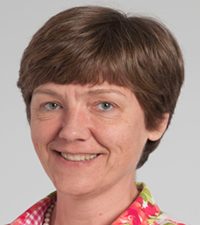Pathways

Volume 6 • Issue 2 • February 2017 • Rheumatology Research Foundation
Crucial Expansion in the Workforce
Rheumatology is facing a significant workforce shortage with more than 41,000 adults for every one board-certified rheumatologist in the United States. Regional variations in access also mean that critical treatment for rheumatic disease is impacted by a patients’ ability to find a physician in their area.
The Rheumatology Research Foundation’s education and training awards advance the specialty by encouraging medical students and residents to choose rheumatology and by providing resources for active rheumatologists to better educate them.
Abby Abelson, MD of the Cleveland Clinic says Foundation preceptorship and fellowship programs have the ability to impact patients, “by supporting these fellowship positions, we have increased the number of rheumatologists who are going to be able to treat all the patients who need rheumatologic care.”
The rapid increase of technologies poses new challenges when it comes to training the next generation of specialists. Foundation awards not only bolster the workforce in numbers, but provide funding for new approaches in education and training to sustain a changing landscape.
Developing tools that adapt to an increasingly digital world can help prepare medical students, residents and fellows for a changing medical field. The web-based rheumatology curriculum of Dr. Uzma J. Haque and the online gaming platform Dr. Arundathi has developed as a teaching tool are some of the many ways the Foundation remains proactive in strengthening the specialty.
The Foundation awarded more than $1.3 million towards education and training programs in Fiscal Year 2017. For details on education and training awards offered by the Foundation, click here.
Funding Leads to Breakthroughs
A new measurement tool could mean big changes for the treatment of rheumatoid arthritis (RA). With funding from the Rheumatology Research Foundation, Gregg Silverman, MD, led a study that developed a means for the measurement of immunologic memory in autoimmune disease. This new tool will allow doctors and researchers to measure the immunologic defects that are the actual cause of a patient’s RA and evaluate the effectiveness of treatment.
Immunologic memory is the ability of the immune system to respond more quickly and effectively to pathogens it has encountered before. Immunologic memory and its defects appear to play an important role in autoimmunity and RA. Dr. Silverman’s research combines the investigation of immunologic memory with autoimmune B cells in order to develop new pathways for RA treatment.
“Until now, arthritis was measured by inflammation and by symptoms. We had no way of knowing whether a treatment was fixing the immune system or just managing the symptoms,” says Dr. Silverman, professor of medicine and pathology at NYU Langone Medical Center . “The tool developed in our Foundation-funded project allows doctors and researchers to measure the immunologic defects that actually cause rheumatoid arthritis. By measuring the number of autoimmune B cells in someone’s immunologic memory, we can now look at the underlying cause of the disease and evaluate the effectiveness of treatment.”
With this data, Dr. Silverman explains that doctors and researchers can better gauge the effectiveness of RA treatments. Such information can be applied to evaluate new, as well as existing RA medications, and help guide the development of a cure.
Dr. Silverman believes the tool will also be adaptable to measure other diseases caused by problems with B cell autoimmune memory, “this information provides researchers with the street signs they need to see if they are on the right track towards developing a cure. It can be applied to evaluate new, as well as existing RA medications, which can help guide the development of a cure or the treatment of individual patients. It also can be adapted to measure other diseases caused by problems with B cell autoimmune memory, such as lupus.”
The impact of Dr. Silverman’s work could benefit patients, researchers, and physicians by providing new avenues for testing and treating the disease itself, as opposed to combatting the symptoms alone.
The study, entitled Disease associated anti-citrullinated protein memory B cells in rheumatoid arthritis persist in clinical remission, has undergone full peer review and was published in Arthritis & Rheumatology.
Visit the improving patient care page to to read more stories, or share your experience by emailing us.
#RheumLife: Controlling Inflammation

Joint damage and inflammation are among the most commonly recognized symptoms of rheumatic disease, despite the limited understanding of the mechanisms behind them. Damage to the joints can significantly impact a patient’s ability to perform daily tasks and can hinder their long-term goals. Researchers investigating the process of inflammation and joint damage could prompt new treatment methods and minimize long-term effects of arthritis and other rheumatic diseases.
|
 Priscilla McKenney Priscilla McKenney
|
Patient Perspective
“It has been one big experiment since 1983 when I was diagnosed with rheumatoid arthritis (RA) at age 23. I was just launching my career as a mountaineering instructor and had sights on climbing Mt. Denali. I didn’t listen to the doctors saying that I had to give those dreams up to adopt a sedentary lifestyle. I had to walk through a lot of pain to continue on my outdoor lifestyle and career. It has been a journey to find what works for me regarding the management of inflammation and taming the autoimmune system, the root cause of my pain.”
|
 Dr. Veronique Lefebvre Dr. Veronique Lefebvre
|
The Efforts to Help
Inflammation in rheumatoid arthritis involves specialized cells called fibroblast-like synoviocytes (FLS) and synovial stem cells (JSCs). After disease onset, FLS and JSCs begin an aggressive, cancer-like behavior that contributes to the progressive destruction of joint tissues. Veronique Lefebvre, PhD of the Cleveland Clinic is using innovative technology and patient-derived stem cells to study the role of FLS and JSCs in order to develop new methods of preventing joint damage in RA. By understanding how FLS and JSCs are created and transformed, Dr. Lefebvre and her team can provide new insights into RA disease mechanisms. The impact of Dr. Lefebvre’s research could determine new treatments to help patients like Priscilla.